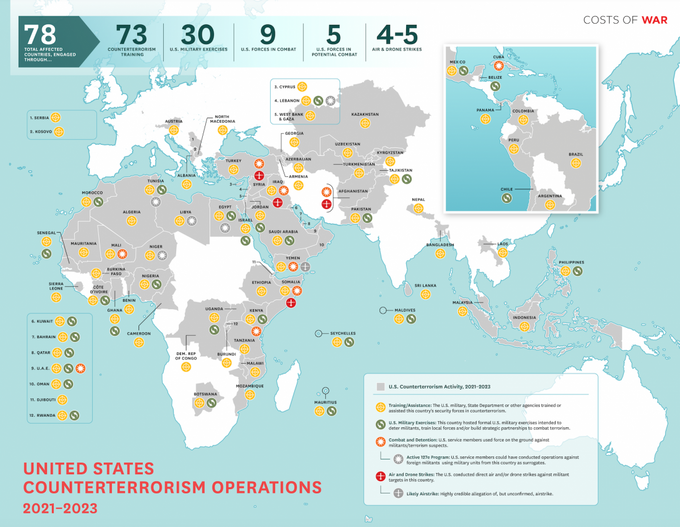JESSICA CORBETT

That's what U.S. House Budget Committee Chair Jodey Arrington (R-Texas) claimed during a Wednesday hearing about controversial legislation backed by Republicans and right-wing Democrats that would create a so-called fiscal commission for the U.S. debt.
Making some on-the-fly additions to his prepared remarks, Arrington said, "120% debt to GDP—this is the highest level of indebtedness in the history of our country surpassing World War II and we're not at war, we're in relative peace and prosperity."
And yet, a report published Wednesday by the Costs of War Project at Brown University's Watson Institute for International and Public Affairs shows that since 2021, the U.S. military has conducted counterterrorism operations—including training and assistance, military exercises, combat and detention, and air and drone strikes—in at least 78 countries.
"The war launched by the United States government in response to the 9/11 terror attacks continues," states the report, authored by project co-director Stephanie Savell. "This map is a snapshot of today's global military and civilian operations that evolved from President George W. Bush's 'Global War on Terror,' launched in 2001, and continued through and beyond the U.S. military's official withdrawal from Afghanistan in 2021. This war on terror continues under President Joe Biden."

The United States conducted air and drone strikes against militants in Afghanistan, Iraq, Somalia, Syria, and likely Yemen, according to the report. U.S. forces also "engaged in combat and detention, using force on the ground against militants/terrorism suspects" in those five countries plus Cuba, Kenya, Mali, and the United Arab Emirates.
The publication also identifies 30 countries where the United States "conducted formal, named military exercises to project
force locally and rehearse scenarios of combating 'terrorists' or 'violent extremist organizations," and 73 nations where the U.S. government "trained and/or assisted military, police, and/or border patrol forces."
As the report details:
Many U.S. military operations are not included here—notably, those aimed at what U.S. officials and media identify as the military threat posed by Russia and China, the focus of much current U.S. foreign policy. Nor does this map include the military bases that have housed counterterrorism operations. Further, it does not include counterterrorism-related arms sales to foreign governments, all deployments of U.S. special operations forces, or all Central Intelligence Agency (CIA) operations. Also excluded are "military information support operations (MISO)," or "psychological operations," which the U.S. military carries out in many countries on the map and beyond, such as in Iran. All of these are significant elements of the bigger picture of U.S. counterterrorism strategy but beyond the scope of the map's data set.
USA Today exclusively reported on the new map. Citing the Pentagon and David Vine, an anthropologist and U.S military expert at American University, the newspaper noted that "there are up to 800 U.S. military bases overseas," and "the Biden administration signed an agreement in June that will bring six new U.S. military bases to Papua New Guinea."
The Costs of War Project report points out that "there are a few notable differences in comparing the current data with the previous version of the map, which covered activities between 2018 through 2020 under President Donald Trump's administration." Differences include that the number of nations hit with U.S. airstrikes decreased while the tally of countries where U.S. service members engaged in ground combat rose by one—the UAE.
"Overall, though the total number of countries has decreased slightly, from 85 to 78 total countries, the United States counterterrorism footprint remains remarkably similar," the report stresses. "Taken altogether, this map's data highlights that the expansive global counterterrorism apparatus grinds ever onwards. This contrasts starkly with claims or assumptions on the part of the U.S. public and policymakers that the so-called 'War on Terror' is over."
The report comes as Congress considers how much more military aid—if any—to provide Ukraine, which has been battling a Russian invasion since February 2022, and Israel, which launched a war on the Gaza Strip in retaliation for a Hamas-led attack on October 7.
"Today, in the current geopolitical context of the Middle East, the U.S. counterterrorism machinery is like a spark, ready to ignite," Savell wrote Wednesday in a related opinion piece for Newsweek. "The U.S. footprint in the region does not only make U.S. forces sitting ducks—it also threatens to dramatically escalate the current war on Gaza. Research has shown that having U.S. troops at the ready in so many places actually makes the chances of the U.S. waging aggressive, offensive wars far more likely."
"It is time for the U.S. to think deeply about the costs of overseas counterterrorism and to admit it has been a failure, underlaid by structural racism," she argued. "It is time to truly end the post-9/11 war era."
No comments:
Post a Comment